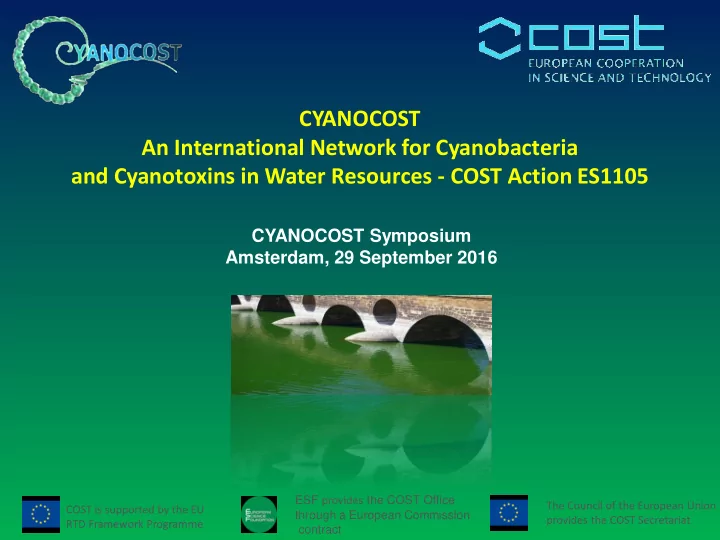

CYANOCOST An International Network for Cyanobacteria and Cyanotoxins in Water Resources - COST Action ES1105 CYANOCOST Symposium Amsterdam, 29 September 2016 ESF provides the COST Office The Council of the European Union COST is supported by the EU through a European Commission provides the COST Secretariat RTD Framework Programme contract
Scientific context & objectives Cyanobacteria • ancient microorganisms globally distributed in biosphere • can form blooms and mats (scums) in surface waters. • some species produce toxins, called cyanotoxins . Toxic blooms • human and animal injuries and deaths worldwide • number of societal and economical impacts The main objective of CYANOCOST ( ES 1105 COST Action MoU) to increase, disseminate and harmonize capabilities across Europe for the risk management of cyanobacteria and cyanotoxins in water bodies, by establishing strong and synergistic links between academia, authorities, industry and citizens” Dissemination of more than 25 years’ worth of relevant research. Strong societal and economic impact: Public health, drinking water utilities, aquaculture, recreational activities, tourism.
On Earth - worldwide occurrence of toxic cyano-blooms Sulejow reservoir, Poland St. John’s river system, FL, USA Balgavies Loch, Dundee, Scotland Satellite sensing of harmful algal blooms in Lake Taihu, China. Cyanobacterial bloom in Lake Erie (satellite image, Sept. 27 2011) - Increased occurrence of blooms could be associated to climate change . - Invasive species and emerging cyanotoxins are further risks under consideration.
Cyanos in space Space colonization, oxygen, fuel and biomass production, nutrient acquisition, and feedstock provisions. Astronauts retrieve cyanobacteria samples from the outside of the ISS Extremophiles Astrobiology Chamber used for simulating conditions on the martian surface.
Relevance and impacts of toxic cyanobacterial blooms Human and animal health Aquaculture – Acute poisoning, chronic Ecosystems effects Fisheries Degradation, Loss of Loss of production diversity Cyanotoxins, off-odours Water treatment Tourism Impacts Closures of recreational Costs for treatment sites Cyanotoxins, off-odours
Number of ANIMALS affected by cyanotoxin poisoning, 1900 to present http://www.sciencedirect.com/science/article/pii/S0160412016300642 Wood, R. "Acute animal and human poisonings from cyanotoxin exposure - A review of the literature." Environment International 91: 276-282.
Number of HUMANS affected by cyanotoxin poisonings, 1920 to present http://www.sciencedirect.com/science/article/pii/S0160412016300642 Wood, R. "Acute animal and human poisonings from cyanotoxin exposure - A review of the literature." Environment International 91: 276-282.
Research on cyanotoxins Merel et.al (2013) Toxicon 76, 118-131
USA: The Toledo water crisis On August 2, 2014, the City of Toledo, Ohio “ Do Not Drink – Do Not Boil” water notice - microcystins . The notice affected more than 400.000 people. Toledo water utilities abstract water from lake Erie, which suffers from cyanobacterial blooms. The water notice issued by the City of Toledo
USA: Response to Toledo water crisis Open data for monitoring of lakes and drinking water supplies (US EPA) Google “Hot Searches”, August 2, 2014 Short – term measures: Continuous monitoring of water supplies for toxins Long – term strategies : limit nutrient runoffs in lake Erie (mainly phosphorus) Toledo mayor, Dr. Michael Collins on August 4, when the water ban was lifted PAUL SANCYA / THE ASSOCIATED PRESS thestar.com
Serbia: The Uzice case In December 2013 there was a widespread bloom of Planktothrix rubescens in lake Vruci which is an artificial water reservoir serving the city of Uzice (ppl. 70.000). The use of water for drinking and preparation of food was forbidden. The WTP switched to an alternative source of water (groundwater). Data regarding the presence of cyanotoxins in water during the episode were not publicized Water tank in Užice . Photo: Milos Cvetkovic
Working groups, Steering Committee Ludek Blaha T. Kaloudis CZ EL Jussi Meriluoto Kaarina Sivonen FI FI Antonio Quesada Luc Brient ES FR Petra Visser Anastasia Hiskia Geoffrey Codd Zorica Svircev NL UK RS EL Individual Participants: 94 - Female: 55%, Early Stage Researchers (ESRs): 18% Total number involved in activities: ~150
Member and participating countries CYANOCOST Network September 2016 Participating (35) * including USA as International Partner + Russian Federation and Armenia as Near Neighbour Countries Not (yet) in the network
Major outputs Four major publications (Handbooks and special issues) 32 Summary chapters 29 SOPs Geoffrey Codd Lisa Spoof Jussi Meriluoto FI UK FI http://eu.wiley.com/WileyCDA/WileyTitle/productCd-1119068681.html
Geoffrey Codd Lisa Spoof Jussi Meriluoto FI UK FI Handbook of Cyanobacterial Monitoring and Cyanotoxin Analysis
Major outputs Four major publications (Handbooks and special issues) Petra Visser Bastian Ibelings Myriam Bormans Jutta Fastner NL CH FR DE http://link.springer.com/journal/10452/50/3
Major outputs Four major publications (Handbooks and special issues) Under development Anastasia Hiskia Dionysios Dionysiou Maria Antoniou Tri Kaloudis Th. Triantis EL USA CY EL EL
Major outputs Four major publications (Handbooks and special issues) “Handbook of Molecular tools and techniques ” Finalized – to be released in early 2017 Annick Wilmotte Nico Salmaso Kaarina Sivonen Rainer Kurmayer BE IT FI AT 11 chapters (Introduction, Sampling, Isolation, Taxonomic identification, nucleic acid extraction, conventional PCR, qPCR, microarrays, DGGE, High throughput sequencing, Application) 44 SOPs 62 Flow diagrams ca. 200 pages
“Handbook of Molecular tools and techniques ” Finalized – to be released in early 2017 Annick Wilmotte Nico Salmaso Kaarina Sivonen Rainer Kurmayer FI AT BE IT Example Overview of protocols on DNA (RNA) extraction from isolated strains, field samples, and food supplements (ch. 5)
Other CYANOCOST Outputs (list and overview only) Collaborative research publications ( 85 ) Pan-European monitoring (B. Ibelings: NETLAKE – CYANOCOST initiative) Joint grant proposals ( e.g. CYANOHAZARD for JPI Water ) European Database (> 1800 records) & Directory of experts (> 200 records) Methods standardization (4 “handbooks”) Workshops, schools, special conference sessions ( 10 ) Researcher exchanges - STSMs ( 37 )
An example of CYANOCOST STSM poster (During 2012-16 total 44 applications received / 37 supported)
Acknowledgements COST office Dr. Deniz Karaca, Science Officer Tania Gonzalez Ovin, Administrative Officer CYANOCOST colleagues and whole network
Recommend
More recommend